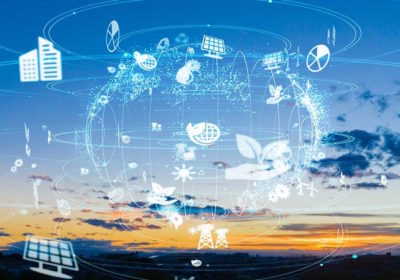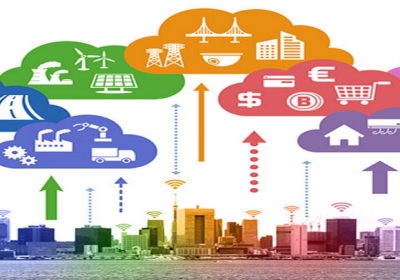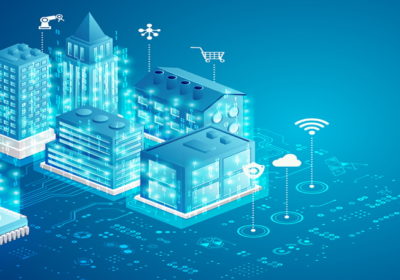
The impact that new technologies are beginning to have on our society is not a new topic of discussion, nor something that has been at all revealing to those of us who have been analyzing for some time how all the development of elements such as blockchain, 5G communications technologies and the incipient development of 6G by China, and the protocols developed to support the so-called cryptocurrencies and their impact on the global economy are going to force us all, as human beings and members of a society that is advancing at tremendously high speeds for what we have been accustomed to in recent decades, to rethink the way we are going to live with each other and what our cities of the future are going to be like.
This future, on the other hand, is already very close, the new socioeconomic models are mixed with digital alternatives so that we can do almost everything within the urban environment in which we move. We can already use an app for practically anything we need to achieve in our day-to-day lives, and we can use instant communication technologies with members of governments, local and regional authorities to send them requests for information, carry out bureaucratic procedures or notify them of problems in the neighborhoods where we live. Everything that used to have to be done in long lines in person, or where physical paperwork was involved, although this has not disappeared, is now at the touch of a finger on a cell phone or on our computer.
Will the whole society be able to make this radical transformation without being plunged into chaos or confusion?
The new generations can do it, they are used to it, as they were born with technology in their arms while they were growing up, but what about those who were born when there were no cell phones or tablets? Can they adapt so quickly to issues such as the digital economy, to the fact that services in their neighborhood have to be requested via email or via app? What will happen when we manage to successfully implement urban transport models based on the non-presence of human drivers? The early-adopters will be the first to get on board, but how long will it take for an “average” adult who is still wary of the processes that technological progress imposes on them to even accept a test to see if they can adapt to them?
The challenges for cities are enormous to incorporate citizens to the new facilities that technologies bring with giant steps and rhythms, because in a demography in which only a small part of the population is willing to jump into using everything that the digital era brings with it, the rest look at it with concern, or at least with indifference, because it is something they do not understand. How will we manage to involve all citizens so that they feel part of the transformation process of our society based on urban development models where all kinds of technological systems that most of us do not understand are mixed together?
More progress or more inequality?
The challenge of smart and connected cities is twofold in this regard, not only do we have to modify the infrastructure of all communication services, Internet, databases, cloud-based computing systems and blockchain where information is stored so that it is visible to everyone simultaneously, but we have to find ways to overcome the resistance of people who fear, or may fear, that all these advances will bring more inequality to the society in which they live, opening and deepening the gap between those who use and understand and quickly adopt the new technologies, and models of use of the same, and those who still do not understand, use or adapt to these for convenience, for relying on what is already established, for lack of interest or simply for lack of knowledge.
It is clear that in any society there are always elements that are at the forefront of development, driving projects and the implementation of improvement systems, changes in the organization and planning of the city or region, and activating and “testing” everything that the industry and technology companies are offering, developing and promoting, but the vast majority of people are in that “long-tail” that goes at a very slow pace of understanding and adapting to the new. Do we lack technological education that we should start to develop and offer free of charge to our citizens so that they can participate more actively in all the new projects that our city can implement? Or do we lack ways to explain and make society easily understand the advantages (and disadvantages) that these rapid developments and changes can bring to their lives?
From city to Smart City
When a city starts its transformation into a Smart City with a long-term plan, institutions and technology hubs, ecosystems of companies and start-ups are the first to start demanding regulations that allow them to set up and accelerate their projects, research and developments, but, when the city is transforming into a Smart City, the resistance of a part of the population that does not want anything to change because it has become accustomed to a way of doing things is also present. How to combine and combine work to help people lose their fear of technological development? How to encourage creativity and research in our companies but prevent them from going so fast that no one can keep up with the pace of the technological products and systems they develop and that we cannot implement? We are starting the deployment of 5G technologies around the world but there are still companies, industrial ecosystems and people who are still connected to a 2G or 3G, and they are doing well, it is more than enough for what they need and they are not particularly interested in changing technology, unless there is no other choice because the one they are using breaks down or is no longer functional.
But is it then necessary to wait for the late-adopters to stop using the “old” completely in order to implement the “new”? It would be more productive to insert and create processes of accompaniment and transformation in society towards the technological models that they want and wish to implement, so that, without ceasing to use that which, for one part works and is sufficient for them, allows them to begin a process of adaptation to the new, to what is proposed as the revolution of urban life, in communications, education, health, economy, transport and all the other areas of life in which these technological changes are going to have a strong impact on us.
Applying new technologies so that no one is left behind
The process that this last lustrum has seen in that aspect in the development and appearance of new protocols derived from blockchain, derived from working with artificial intelligence, with the so-called “machine learning”, with the creation of virtual assistants and chatbots that respond to us almost as if they were human but that can arouse a complete rejection to those who still prefer to talk to a person when they have a problem in any service they have hired or may have needed, arises more as a need for understanding and empathy and training, than as an imposition of the industry towards a digital transformation that cannot go only hand in hand with those who push forward for a faster and faster and more agile development, but has to be accompanied by the whole of the population that cannot be left behind. Like a comet, which always pulls its tail at the same speed at which its head advances, without letting any of the parts that form it lag behind to disperse or get lost on the path along which it advances, likewise, the urban transformation of society cannot leave behind the vast majority while it takes place, but must accompany people to understand the changes that will occur while their technological ecosystem allows and facilitates these changes. Only in this way will our society stop “stretching” like a rubber band in which there is an increasing difference between those who are ahead and those who are lagging behind, because, practically, at the rate we are evolving, we will have achieved in a few years of technological progress what the whole of humanity has not advanced in the whole of its history as a civilization, and this leads us to the risk that the part that is lagging far behind will become “marginalized” in the processes of social and urban transformation that we are carrying out.
To avoid this, we propose viable alternatives that can be implemented from this very moment, starting by breaking the fear of technological change with all kinds of social and cultural events for those who will never go to a conference on the Internet, cell phones or new transportation or communication alternatives. Bringing progress closer to those who are now looking for a way to adapt to an urban ecosystem that is constantly changing and that always reaches the general public several years behind the “latest model” of what the industry is researching or launching in its laboratories and research departments.
In addition, it is necessary to search for protocols to reduce the psychological impact that the digital transformation of society may have on it, towards a model where everything is computerized, where everything is done over the Internet or through human-machine interaction systems, where you go to order a coffee and you are served by an automated system that is designed to prepare it exactly as you want it, or where the shopping list you make every week at the supermarket is already recorded in an app on your cell phone and you only have to press a button to have it delivered to your home without any other interaction between you and those who have been in charge of preparing it and bringing it to you. The fear that can arise from the loss of interaction between people, the “warm” touch that can permeate when someone has a problem and empathetically another person can solve it for you from any customer service, will possibly disappear if all we will be served in 10 or 20 years are chatbots and artificial intelligences that will navigate through all the options of all the menus of all the systems and products we have contracted to solve our questions, doubts or complaints that we may have, so perfectly and objectively, that it will be difficult to discharge any frustration with this type of help or response systems.
When we can go to the park and from an app open the water fountain to refresh ourselves and report that a tree has fallen in the middle of a street due to strong wind directly to the fire department (something that can already be done in many cities), or when we can request a medical appointment and be attended by video consultation wherever we are (something that is already possible also in certain places with good connectivity), society will no longer be subject to physical spaces and locations and to operational limits, since services for citizens can be provided hundreds of kilometers away from their “physical” residence within the “physical” perimeter of the city itself.
Digital citizen, virtual resident
Thus, the so-called “digital operability” is expanded to the citizen who does not need physical presence to be part of what his Smart City allows him to do, the concept of “resident” in a city is expanded, since being able to control your entire house from thousands of kilometers away with home automation and technological systems, it is difficult to differentiate whether you live in it or if you only maintain it remotely. In short, the concept of citizenship is extended to the world of digital identity where a passport or physical document with an address written on it will not be fully indicative of the reality of that person, nor of their status as a permanent inhabitant of that city. On the other hand, teleworking and remote connection to companies in the city can become a challenge that is already being widely implemented in many places, cities and countries, and it does not matter where you live to be able to say that you work in Barcelona or Sao Paulo, because your residence is not an indication that you are not carrying out your profession in a company whose headquarters are thousands of miles away from you, counting as an employee and registered in that location, but leading your life at another point far away from it.
Finally, the possibility that human interactions will change with technological developments is already a fact and, therefore, a reality implemented in many areas of our modern society. We will get used to talking to machines that will have all the answers we need and it will be of little or no help to call a co-worker to meet with them because your co-workers are spread over five different countries each, but all within a single digital location that will belong to a company within a city connected to the network and, from which, we will also be able to carry out things that are now little less than science fiction.
Let’s see how to assist the entire population so that no one is left behind, that we manage to break down the psychological barriers of rejection to change, that we find ways and integrating elements to accompany this change and that it is done progressively and gradually, without ceasing to assist and support those who are years ahead in knowledge, inventiveness and development, so that what these technological ecosystems, business hubs and start-ups develop, reaches everyone else as quickly and comfortably as possible, and allows us to embrace the assistance that technology offers us without losing the sense of human society that unites us and makes us unite among us all for the greater common good of our civilization.



